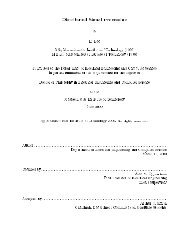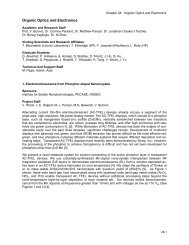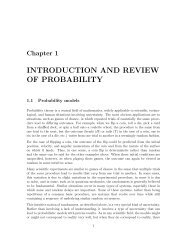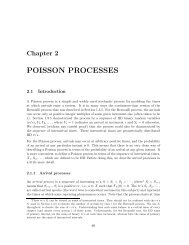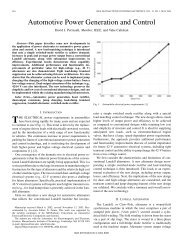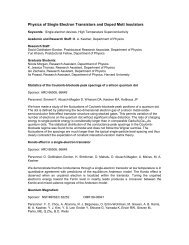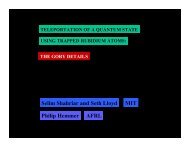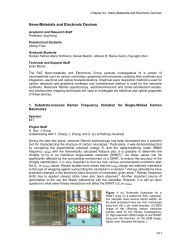A 24 Gb/s Software Programmable Analog Multi-Tone - Research ...
A 24 Gb/s Software Programmable Analog Multi-Tone - Research ...
A 24 Gb/s Software Programmable Analog Multi-Tone - Research ...
You also want an ePaper? Increase the reach of your titles
YUMPU automatically turns print PDFs into web optimized ePapers that Google loves.
1002 IEEE JOURNAL OF SOLID-STATE CIRCUITS, VOL. 43, NO. 4, APRIL 2008<br />
Fig. 3. (a) Signal waveforms in an example 2-channel AMT system. Two-tap equalizers per sub-channel at the transmitter, ideal channel, and no DFE at the<br />
receiver. Continuous-time ISI and ICI patterns are shown at the sampler inputs. (b) A 2-way parallelized 4-tap linear equalizer and a 2-channel 4-tap per channel<br />
AMT equalizer.<br />
dently. 2 In other words, the AMT equalizer is a general form<br />
of a BB equalizer. The additional degrees of freedom in the<br />
AMT equalizer enable the AMT system to shape the transmit<br />
spectrum better than a BB system. As a result, an AMT system<br />
performs considerably better than a BB system over channels<br />
with notches in their frequency response or in the presence of<br />
frequency selective interference, where optimal shaping of the<br />
transmit spectrum is crucial. Over smooth channels, however,<br />
where both AMT and BB can achieve close to optimum transmit<br />
power allocation, for the same transmit peak voltage, the AMT<br />
system can put less signal energy on the line compared to a BB<br />
system, because a MT signal in general has a higher peak-to-average<br />
power ratio (PAPR) than a single-tone signal. Therefore,<br />
BB signaling may be optimal for signal transmission over these<br />
kinds of channels.<br />
Fig. 3(b) also indicates that an AMT transmitter can be built<br />
to support BB signaling with very small overhead. Such a transmitter<br />
can achieve the best performance over a very wide range<br />
of channel characteristics using either AMT or BB transmission<br />
depending on which one is optimal. Section VII describes this<br />
type of transmitter designed to support <strong>24</strong> <strong>Gb</strong>/s in both AMT<br />
and BB modes.<br />
III. TRANSMITTER ARCHITECTURE<br />
The <strong>24</strong> <strong>Gb</strong>/s transmitter, fabricated in a 90 nm CMOS technology,<br />
includes an on-chip pattern generator (PG), a linear<br />
2 Same complexity (power) argument applies to the MIMO DFE in the receiver<br />
of the AMT system as well, and the argument is independent of whether<br />
FFE and DFE are implemented in digital domain or as pseudo-DAC current<br />
mode equalizers.<br />
equalizer, and a DAC. The design of the equalizer in the digital<br />
domain, with 16 10-bit full-range taps, makes the transmitter<br />
a platform with sufficient flexibility to enable evaluation<br />
of different transmission algorithms in different environments.<br />
Fig. 4(a) shows the top level block diagram of the transmitter.<br />
The PG creates <strong>24</strong> <strong>Gb</strong>/s of pseudo-random (PN) binary data<br />
for the system in the form of four (2-way parallelized) 3 GS/s<br />
4 PAM (or 2 PAM) sequences. The 16-tap linear equalizer is<br />
parallelized four ways with each parallel branch allowed to take<br />
independent tap values. This way the transmitter can be configured<br />
to support 4-channel and 2-channel AMT, as well as<br />
multi-PAM BB signal transmission ranging from 2 to 256 PAM.<br />
Each parallel branch of the equalizer is 2-way parallelized to operate<br />
with a 1.5 GHz clock and receives a 4 PAM (or 2 PAM) sequence<br />
as input. A thermometer encoder, included at the output<br />
stage of the equalizer, converts the three most significant bits<br />
of the output to unary code. An on-chip 8-bit 12 GS/s 2-way<br />
output multiplexed current-mode DAC converts the digital outputs<br />
to an analog signal and directly drives the 50- chip output.<br />
Fig. 4(b) shows the clock network of the transmitter. The<br />
system uses an external 12-GHz reference signal along with<br />
CML frequency dividers to minimize the impact of clock jitter<br />
and achieve optimum duty cycle for the synchronizing half-rate<br />
clock. The 6 GHz half-rate clock is further divided on-chip to<br />
create the 3 GHz clock required for the DAC, and the 1.5 GHz<br />
clock required for the digital equalizer and the PG. A phase interpolator<br />
and a phase detector are placed at the interface between<br />
the DAC and the equalizer to ensure the two circuits have<br />
independent clock distribution networks without potential setup



